Rathasaptami, Ratha-saptami: 11 definitions
Introduction:
Rathasaptami means something in Hinduism, Sanskrit, the history of ancient India, Marathi. If you want to know the exact meaning, history, etymology or English translation of this term then check out the descriptions on this page. Add your comment or reference to a book if you want to contribute to this summary article.
In Hinduism
Purana and Itihasa (epic history)
Source: Cologne Digital Sanskrit Dictionaries: The Purana IndexRathasaptami (रथसप्तमि).—The Saptami of the month of Māgha when the sun turns his chariot; fit for making gifts and performing śrāddha to please Pitṛs.*
- * Matsya-purāṇa 17. 9-10.

The Purana (पुराण, purāṇas) refers to Sanskrit literature preserving ancient India’s vast cultural history, including historical legends, religious ceremonies, various arts and sciences. The eighteen mahapuranas total over 400,000 shlokas (metrical couplets) and date to at least several centuries BCE.
India history and geography
Source: archive.org: South Indian FestivitiesRatha-saptami.—The Hindu festival going by the name ‘Ratha-saptami’ is observed on the seventh day of the bright fortnight in the month of Magha, called also in Tamil ‘Tai Masam’, corresponding to the English month January–February when the sun is in the Makara. Different names have also been bestowed on the festival in question. Some call it ‘Magha-saptami’ deriving the name from the month in which it is considered auspicious.
The word saptami is derived from the Sanskrit word ‘sapta’ which means seven, and consequently the expression ‘Magha-saptami’ is taken to mean the seventh ‘tithi’ or the day after the ‘purnima’ (full-moon) or the ‘amavasya’ (new-moon) in the month of Magha. Here it is the seventh day in the bright fortnight in the said month.
Some people call it Jayanti-saptami and others Maha-saptami. The expression Jayanti-saptami means the victorious seventh day after the full-moon day and that going by the name ‘Maha-saptami’ means ‘the great seventh day’ in the fortnight. The name Jaya-saptami originated perhaps from the belief that the observance of this festival brought success in all undertakings and the other, Maha-saptami, from the importance attached to this saptami of all the saptamis in the year, as specially auspicious.
Source: Cologne Digital Sanskrit Dictionaries: Indian Epigraphical GlossaryRatha-saptamī.—(EI 22; CII 4; IA 17), an auspicious tithi; same as Māgha śu-di 7. Note: ratha-saptamī is defined in the “Indian epigraphical glossary” as it can be found on ancient inscriptions commonly written in Sanskrit, Prakrit or Dravidian languages.

The history of India traces the identification of countries, villages, towns and other regions of India, as well as mythology, zoology, royal dynasties, rulers, tribes, local festivities and traditions and regional languages. Ancient India enjoyed religious freedom and encourages the path of Dharma, a concept common to Buddhism, Hinduism, and Jainism.
Languages of India and abroad
Marathi-English dictionary
Source: DDSA: The Molesworth Marathi and English Dictionaryrathasaptamī (रथसप्तमी).—f (S) The seventh day of the bright half of māgha.
Source: DDSA: The Aryabhusan school dictionary, Marathi-Englishrathasaptamī (रथसप्तमी).—f The seventh day of the bright half of māgha.
Marathi is an Indo-European language having over 70 million native speakers people in (predominantly) Maharashtra India. Marathi, like many other Indo-Aryan languages, evolved from early forms of Prakrit, which itself is a subset of Sanskrit, one of the most ancient languages of the world.
Sanskrit dictionary
Source: DDSA: The practical Sanskrit-English dictionaryRathasaptamī (रथसप्तमी).—the seventh day in the bright half of Māgha.
Rathasaptamī is a Sanskrit compound consisting of the terms ratha and saptamī (सप्तमी).
Source: Cologne Digital Sanskrit Dictionaries: Aufrecht Catalogus CatalogorumRathasaptamī (रथसप्तमी) as mentioned in Aufrecht’s Catalogus Catalogorum:—from the Vratārka. L.. 535.
Source: Cologne Digital Sanskrit Dictionaries: Monier-Williams Sanskrit-English DictionaryRathasaptamī (रथसप्तमी):—[=ratha-saptamī] [from ratha] f. Name of the 7th day in the light half of the month Āśvina (so called as the beginning of a Manv-antara when a new Sun ascended his car), [Horace H. Wilson]
[Sanskrit to German]
Sanskrit, also spelled संस्कृतम् (saṃskṛtam), is an ancient language of India commonly seen as the grandmother of the Indo-European language family (even English!). Closely allied with Prakrit and Pali, Sanskrit is more exhaustive in both grammar and terms and has the most extensive collection of literature in the world, greatly surpassing its sister-languages Greek and Latin.
Kannada-English dictionary
Source: Alar: Kannada-English corpusRathasaptami (ರಥಸಪ್ತಮಿ):—[noun] the sevent day of Māgha, the eleventh month of Hindu lunar calender.
Kannada is a Dravidian language (as opposed to the Indo-European language family) mainly spoken in the southwestern region of India.
See also (Relevant definitions)
Partial matches: Ratha, Saptami.
Starts with: Rathasaptamikalanirnaya, Rathasaptamipuja, Rathasaptamisnanavidhi, Rathasaptamivrata, Rathasaptamivratakalpa.
Query error!
Full-text: Rathasaptamipuja, Rathasaptamivrata, Rathasaptamikalanirnaya, Rathasaptamisnanavidhi, Ratacaptami.
Relevant text
Search found 6 books and stories containing Rathasaptami, Ratha-saptamī, Ratha-saptami, Rathasaptamī; (plurals include: Rathasaptamis, saptamīs, saptamis, Rathasaptamīs). You can also click to the full overview containing English textual excerpts. Below are direct links for the most relevant articles:
Vedic influence on the Sun-worship in the Puranas (by Goswami Mitali)
Sun-worship Vratas (38) Ratha-saptamī < [Chapter 5 - Rituals Related to the Sun-Worship in the Purāṇas]
Part 4 - The Vratas Observed and the Sun-worship < [Chapter 5 - Rituals Related to the Sun-Worship in the Purāṇas]
Part 10 - Temples and Pilgrimages for Worshipping the Sun-god in the Purāṇas < [Chapter 4 - Vedic Influence on the Sun-Worship in the Purāṇas]
Notices of Sanskrit Manuscripts (by Rajendralala Mitra)
Page 133 < [Volume 13 (1898)]
Rasa Jala Nidhi, vol 5: Treatment of various afflictions (by Bhudeb Mookerjee)
Part 3 - The Age of the Mahabharata War < [A Brief History of Indian Chemistry and Medicine]
The Sun-Worshipping Sakadvipiya Brahmanas (by Martina Palladino)
3.1. Two other poems: The Sāmvavijaya < [Chapter 3 - Late Poems]
2. Interview Results < [Chapter 5 - A Chat and a Chai]
Skanda Purana (by G. V. Tagare)
Chapter 205 - Brāhmaṇas Unfit for Śrāddha < [Section 1 - Prabhāsa-kṣetra-māhātmya]
Chapter 46 - Description of Lolārka < [Section 1 - Pūrvārdha]
Chapter 43 - Establishment of Bhaṭṭāditya < [Section 2 - Kaumārikā-khaṇḍa]
Studies in the Upapuranas (by R. C. Hazra)
Related products

